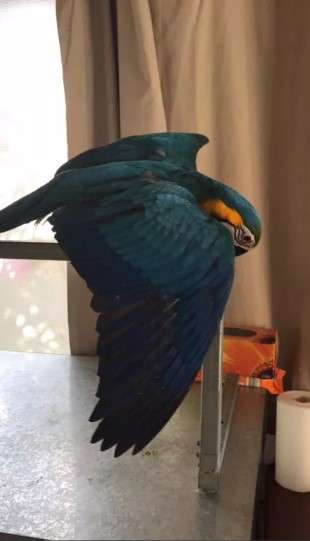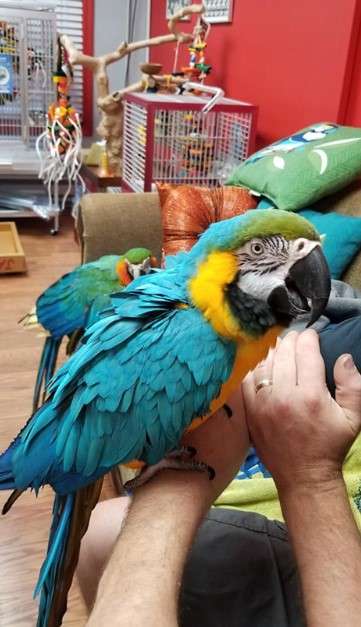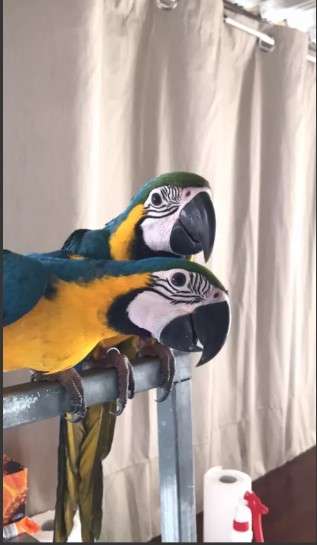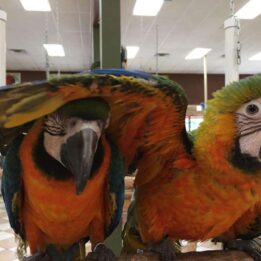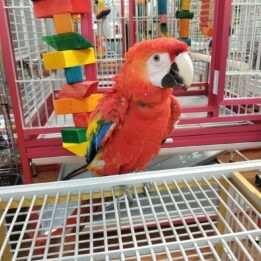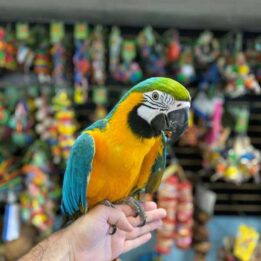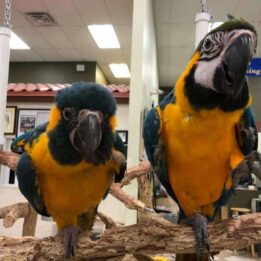Blue and Gold Macaw for sale. All birds are sexed. They come with a DNA test, Birth Certificate and are well raised and socialized. Eats fruit veggies and pellets. All macaws have been hand raised and come with DNA sexing certificates. They are all weaned and ready to go now. They will make beautiful pets, extremely tame and sooky birds.
The Blue Gold macaw is one of the most popular of all macaws, due to the mild temperament and high intelligence. The Blue Gold macaw is a great bird.
However, most people could not keep such a large bird such as a blue gold macaw. The lucky ones that commit such a bird are in for a treat. The upper side of the tail, wings, backside, and neck are rich, deep blue. Underparts are bright golden yellow. The underside of the tail is blue tinged with yellow. The crown is greenish tinged with blue. A black bib collar frames the lower part of the face. Sizes can be anywhere from 30 inches to smaller in length.
All of our birds are treated equally and with the utmost respect and care. We believe that the way you raise your young determines the way they will behave in the future. We take pride in what we do, ensuring the quality of parrots we breed and raise are always up to expectation.
You are not just buying a parrot, you are buying a friend for life!
The most important stage in a parrots life is the first ten to twelve weeks, in this time we mold the parrots and work closely with them to positively influence their attitude, character, and personality.
All our parrots are bred and raised in a friendly family orientated environment, to ensure the connection between human and parrot is frequent and varied. We like to spend quality time before and after feeds as this is the best time for the birds to bond.
Colors and Markings
Blue and gold macaws get their common name from their two most prominent feather colors. They typically have a green forehead, fading into a teal blue which covers the nape, back, tail, and wings. The chest and underside of the wings and belly are a bright golden yellow.
These birds have large black beaks and a black patch of feathers just underneath it. White patches of skin adorned with rings of tiny black feathers surround their eyes and cover much of the face.
The males and females are barely distinguishable because this is a monomorphic species. It’s believed that the male has a flatter head and the female has a narrower beak, but the only way to prove the sex of this macaw is through surgical or DNA sexing.
Personality & Behavior
Intelligent and sociable, the blue and gold macaw usually does well as a pet when the owners are dedicated, responsible, and well informed. They are large birds, and as such are capable of extremely loud vocalizations. Because of this, they may not be the best choice for those who live in apartments and condominiums, or who have small children.
When allowed to socialize with a variety of people, blue and golds do very well adapting to various situations. They’re a popular headliner at bird shows, and many owners take them out and about town with the help of bird leashes and car seats. Blue and golds can be just as welcoming to other birds as they are to humans.
Around the house, these macaws can be as friendly as a dog. They enjoy being near their owners and will often wander around looking for someone who can give them attention. Their sweet personality is sure to make you drop whatever you’re doing for a little playtime. They can also be quite content on their perch, watching the activity around them.
Caring for Blue and Gold Macaws
Their sociability and even temperaments mean that blue and golds make great pets. Adding to that, their intelligence, willingness to learn, and talking ability only help make them more precious in the eyes of bird lovers.
Like most parrots, the blue and gold thrives on attention from its owner and will form a strong bond with its family members. This is not to say, however, that the blue and gold macaw is for everybody. Indeed, this is a bird that requires extra special attention.
They are quite large and must be provided with adequate space in which to live, play, and exercise. Not only that, but they are prone to ear-shattering vocalizations and contact calls, which are often unappreciated by close neighbors. Care must be taken to socialize these birds properly and to provide them with adequate mental stimulation so that screaming doesn’t become a habit out of boredom. These are raucous birds that require plenty of space, a lot of time and attention, and a healthy diet.
The blue and gold is a fantastic bird for tricks. They learn quickly and aim to please, so training is relatively simple as long as you’re consistent. A vocabulary of around 20 words and phrases can be learned as well, and the clarity of their voice makes many people consider them one of the best talking parrots.
When blue and golds are kept in healthy, wholesome environments, they are normally a joy to have as pets. Those who are looking to add a blue and gold to their families, however, should do plenty of research before they buy a bird. You need to make sure that you can provide the kind of home that will be conducive to a healthy, successful ownership experience. Doing so will help ensure that both bird and you enjoy many happy years together.
Feeding
Captive blue and gold macaws should be fed a varied diet consisting of as many different types of fresh foods as possible. Fresh vegetables, including leafy greens and root vegetables, are required as well.
The bird’s diet should be supplemented daily with a high-quality pelleted diet and some healthy seed such as flax, hemp, and chia seed. Do be careful to avoid treats that are high in fat because pet parrots can gain excess weight and even become obese.


